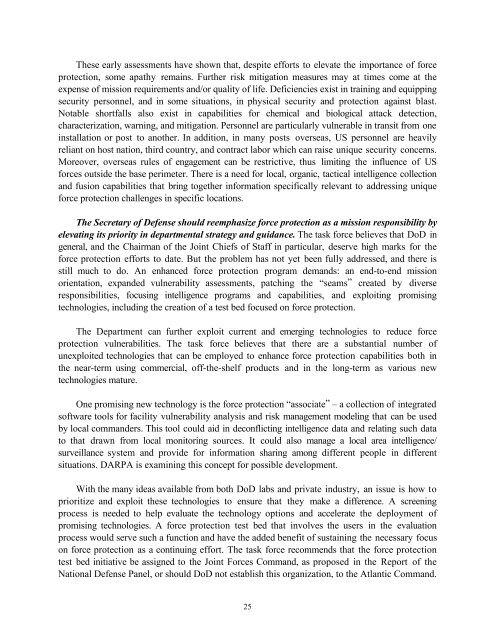DoD Responses to Transnational Threats - The Black Vault
DoD Responses to Transnational Threats - The Black Vault
DoD Responses to Transnational Threats - The Black Vault
You also want an ePaper? Increase the reach of your titles
YUMPU automatically turns print PDFs into web optimized ePapers that Google loves.
<strong>The</strong>se early assessments have shown that, despite efforts <strong>to</strong> elevate the importance of force<br />
protection, some apathy remains. Further risk mitigation measures may at times come at the<br />
expense of mission requirements and/or quality of life. Deficiencies exist in training and equipping<br />
security personnel, and in some situations, in physical security and protection against blast.<br />
Notable shortfalls also exist in capabilities for chemical and biological attack detection,<br />
characterization, warning, and mitigation. Personnel are particularly vulnerable in transit from one<br />
installation or post <strong>to</strong> another. In addition, in many posts overseas, US personnel are heavily<br />
reliant on host nation, third country, and contract labor which can raise unique security concerns.<br />
Moreover, overseas rules of engagement can be restrictive, thus limiting the influence of US<br />
forces outside the base perimeter. <strong>The</strong>re is a need for local, organic, tactical intelligence collection<br />
and fusion capabilities that bring <strong>to</strong>gether information specifically relevant <strong>to</strong> addressing unique<br />
force protection challenges in specific locations.<br />
<strong>The</strong> Secretary of Defense should reemphasize force protection as a mission responsibility by<br />
elevating its priority in departmental strategy and guidance. <strong>The</strong> task force believes that <strong>DoD</strong> in<br />
general, and the Chairman of the Joint Chiefs of Staff in particular, deserve high marks for the<br />
force protection efforts <strong>to</strong> date. But the problem has not yet been fully addressed, and there is<br />
still much <strong>to</strong> do. An enhanced force protection program demands: an end-<strong>to</strong>-end mission<br />
orientation, expanded vulnerability assessments, patching the “seams” created by diverse<br />
responsibilities, focusing intelligence programs and capabilities, and exploiting promising<br />
technologies, including the creation of a test bed focused on force protection.<br />
<strong>The</strong> Department can further exploit current and emerging technologies <strong>to</strong> reduce force<br />
protection vulnerabilities. <strong>The</strong> task force believes that there are a substantial number of<br />
unexploited technologies that can be employed <strong>to</strong> enhance force protection capabilities both in<br />
the near-term using commercial, off-the-shelf products and in the long-term as various new<br />
technologies mature.<br />
One promising new technology is the force protection “associate” – a collection of integrated<br />
software <strong>to</strong>ols for facility vulnerability analysis and risk management modeling that can be used<br />
by local commanders. This <strong>to</strong>ol could aid in deconflicting intelligence data and relating such data<br />
<strong>to</strong> that drawn from local moni<strong>to</strong>ring sources. It could also manage a local area intelligence/<br />
surveillance system and provide for information sharing among different people in different<br />
situations. DARPA is examining this concept for possible development.<br />
With the many ideas available from both <strong>DoD</strong> labs and private industry, an issue is how <strong>to</strong><br />
prioritize and exploit these technologies <strong>to</strong> ensure that they make a difference. A screening<br />
process is needed <strong>to</strong> help evaluate the technology options and accelerate the deployment of<br />
promising technologies. A force protection test bed that involves the users in the evaluation<br />
process would serve such a function and have the added benefit of sustaining the necessary focus<br />
on force protection as a continuing effort. <strong>The</strong> task force recommends that the force protection<br />
test bed initiative be assigned <strong>to</strong> the Joint Forces Command, as proposed in the Report of the<br />
National Defense Panel, or should <strong>DoD</strong> not establish this organization, <strong>to</strong> the Atlantic Command.<br />
25





![Combat Support in Korea [270 Pages] - The Black Vault](https://img.yumpu.com/49796461/1/190x71/combat-support-in-korea-270-pages-the-black-vault.jpg?quality=85)











